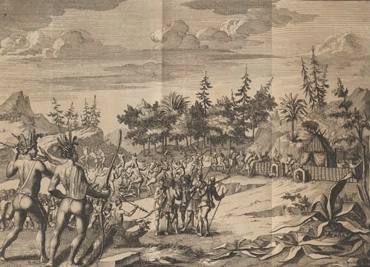In the early 1600’s, it was believed that Sassafras was a wonder drug that could cure just about anything, slow old age, help as a pain reliever, remove kidney stones, and prevent colds. It became so popular that by the mid 1600’s it was Americas’ number two export to Europe, second only to tobacco.
The first expedition to the New World for sassafras was led by Captain Martin Pring in 1602. It was sponsored by the mayor, alderman and merchants of Bristol, including the famous historian, Richard Hakluyt. They obtained their license from Sir Walter Raleigh, who had been granted a royal charter “to explore, colonize and rule any remote, heathen and barbarous lands, countries and territories, not actually possessed of any Christian Prince or inhabited by Christian People”.
Two ships made the journey – the Speedwell, a 60-ton vessel commanded by Pring with a crew of 30 and the Discoverer, a 26-ton vessel with 13 men captained by William Browne and Robert Salterne. They arrived at Penobscot Bay, Maine in June 1603 and then followed the coast south to the mouth of Piscataqua River, where they disembarked and found little sassafras. They sailed further south and anchored at the mouth of Pamet River, near Cape Cod where they discovered abundant supplies of sassafras. Here they set up camp and built a small barricade to protect them from possible attack from the local Wampanoag.
Initially, they had numerous friendly encounters with the local Wampanoag. Pring wrote in his account of the voyage (Burrage, 1906): “During our abode on shore, the people of the country came to our men sometimes ten, twenty, forty or three score, and at one time one hundred and twenty at once. We used them kindly and gave them diverse sorts of our meanest merchandise. They did eat peas and beans with our men. Became We had a youth in our company that could play upon a Gittern [Medieval bowl lute], in whose homely music they took great delight … and danced twenty in a Ring, and the Gittern in the midst of them, using many Savage gestures, singing lo, la, lo, la, la, lo: him that first brake the ring, the rest would knock and cry out upon.“
Not all the early encounters were congenial; however, as Pring and his crew enjoyed tormenting the locals with their two mastiffs. “We carried with us from Bristol two excellent Mastiffs, of whom the Indians were more afraid, than of twenty of our men”. When Pring and his crew became bored “we would let loose the Mastiffs, and suddenly with outcry’s they would flee away.”
By the end of July, the crew had finished loading the Discover “with as much Sassafrass as we thought sufficient”and Pring sent it home. The crew then began filling the hold of the Speedwell when all hell broke loose. Several men in their barricade were confronted by “about seven score Savages armed with their bows and Arrows” and their ship was attacked by a large force of warriors. The men in the barricade were lucky to have the two mastiffs who cleared a path back to the ship through the Wampanoag. Pring immediately set sail for England and as they left, the Wampanoag set the woods on fire and “they came down to the shore in great number, very near two hundred by our estimation.”
Pring didn’t record what they had done to wear out their welcome, but the attack may have been a last ditch effort by the Wampanoag to get as much from the English as they could before they left. It is also possible that the Wampanoag were reacting to Pring snatching some captives to take back to England, a common practice among European explorers at that time. We will never know.
Bibliography
Burrage, H. S. (ed.) (1906) Early English and French voyages 1534-1608, Chiefly from Hakluyt. In: Original Narratives of early American History, Jameson J. F. (ed.) Charles Scribner’s Sons, New York
Morison, Samuel Eliot (1971). European discovery of America: The Northern voyages.Oxford University Press.
Illustration – Engraving of Pring’s fortification and surrounding Ameridians from 1706 Dutch translation of the account from Purchas.
For more histories of agriculture and trade: https://www.worldhistory.org/user/geneticsofberries

One thought on “Precolonial North American History: The great sassafras hunt of Martin Pring”